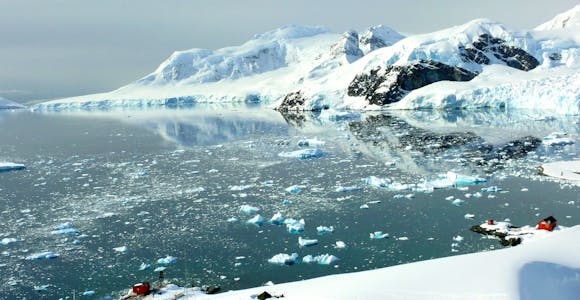
Antarctic Peninsula Cruises
The Peninsula is the classic way to experience Antarctica. Some of the best wildlife and most dramatic scenery can be found in this part of the Frozen Continent.
Discover MoreSpecial Offers Available: Swoop has access to the widest range of offers and can help you find the right trip, cabin, & price.
Expert impartial advice at no extra cost: no-nonsense advice on 1500 voyages across 30 ships
The Antarctic Experts. No Compromises: there’s no question we can’t answer
The only B Corp certified Antarctic specialist: so your adventures can be a force for good
A full concierge service, unlike booking direct: we leave nothing to chance in delivering your perfect trip
Special Offers Available: Swoop has access to the widest range of offers and can help you find the right trip, cabin, & price.
Expert impartial advice at no extra cost: no-nonsense advice on 1500 voyages across 30 ships
The Antarctic Experts. No Compromises: there’s no question we can’t answer
The only B Corp certified Antarctic specialist: so your adventures can be a force for good
A full concierge service, unlike booking direct: we leave nothing to chance in delivering your perfect trip

The Drake Passage is the stretch of ocean lying between South America and the Antarctic Peninsula that all expedition cruise ships must cross to reach the 7th Continent. Though notorious for some travellers, the majority of passages are actually quite smooth – with beautiful albatrosses accompanying you all the way south.
10/10 - We wanted to experience the Drake Passage (which was benign!) but didn't particularly want to spend another 2 days doing it again so this combination worked perfectly. Read the full review
Travelled: February 2025
Robert Bown - UK
We were nervous and excited. We were very lucky with the weather and we got the Drake Lake both ways!! Read the full review
Travelled: January 2025
Louise Harris - USA
10/10 - I wanted the experience of crossing the Drake but was also interested in limiting days at sea. The entire trip was amazing!
Travelled: January 2025
Jo Taylor - USA
10/10 - Flying one way was great, we had so much time on the continent and our team were wonderful. Read the full review
Travelled: January 2025
Ryan Ward - USA
10/10 - The trip was amazing. Doing the Drake Passage once to experience it was our plan. In the planning stage we had not really thought about it being a two day sail so we were happy to only do it once. We much preferred spending our time in Antarctica.
Travelled: January 2025
Mary Anne Mercer - Canada
After a rough Drake crossing, we woke up at 4 am, opened the blinds, and VOILA we were in Antarctica. Icebergs, penguins, even a whale. It was surreal.
Travelled: January 2025
Amy Gold - USA
Most memorable moment? The first sighting of icebergs and glaciers after passing Drake Passage. The Drake Shake was pretty memorable too. Read the full review
Travelled: January 2025
Shin Hao Julius Tan - Singapore
We went through some pretty rough waves getting down the Drake Passage and the ship maneuvered beautifully. The captain was a pro; we enjoyed having a tour of the bridge with him. Read the full review
Travelled: January 2025
Randy Williams - USA
10/10 - Great trip. You see a lot. Downtime there and back to relax or work out. The Drake Passage was pretty calm for us. Food amazing. Read the full review
Travelled: January 2025
Christine Eileen Meckley - USA
Don't stress too much about the Drake Passage and take it as it unfolds. Prepare with medication if you are susceptible to sea sickness, but know that there is a doctor aboard who can also help. Read the full review
Travelled: December 2024
Monica Collins - South Africa
Most memorable moment? Camping and the Drake Shake. Also loved getting to know people from around the world with very different lives. Read the full review
Travelled: December 2024
Kashyap Tumkur - USA
Be prepared for two days on the Drake Passage, going. Celebrate your conquest of it on the way back. Read the full review
Travelled: November 2024
David Allen - USA
The 4 days of Drake Passage crossing (to and from the Peninsula) were great for getting to know the ship, the crew, and learning about the history of the area. Read the full review
Travelled: February 2024
Jennifer Webb - Canada
Expedition team kept us occupied on the Drake with talks of sea birds and seals, history and humpbacks. They didn't even mind too much when we had a hard time staying awake due to sea sick meds! Read the full review
Travelled: January 2024
Becky Ahern - USA
Cross the "Drake", it's worth the experience - don't fly! Read the full review
Travelled: January 2024
Joanne March - USA
I felt well prepared, despite my trepidation for the Drake Passage crossing. Read the full review
Travelled: January 2024
Nathalie Parent - France
Was excited and a little scared, particularly of sea sickness. In the end it was all OK and the experience was amazing. Read the full review
Travelled: December 2023
(Aaron) Boo Boon Khoo - Malaysia
I was excited to see the penguins. I never had any anxiety about the Drake Passage - millions of other people have survived the crossing and I will too! Read the full review
Travelled: December 2023
Juanita Chase - USA
I was apprehensive with the Drake Passage and was apprehensive about the long journey to the End of the World, BUT it all worked out fine and whatever difficulty we had to go through was well worth it. Read the full review
Travelled: December 2023
Rozini Binti Mohd Amin - Malaysia
Go with no expectations and just enjoy every moment including sea days - we saw so many whales/dolphins/seals/birds and so much more on sea days. Read the full review
Travelled: December 2023
Mary Abraham - USA
Most memorable moment? Waking up to the view of the icebergs after two days of seeing only water crossing the Drake Passage. Read the full review
Travelled: December 2023
Nidia Eileen Diaz - USA
No one had control of the weather, but in our case the weather was nearly perfect. The travel across the Drake Passage was mild (we were told the worst day was a 3 of 10). Read the full review
Travelled: November 2023
Michael Robert Perata - USA
Be sure to plan for the Drake Passage. It's hard to understand it and imagine what the sea is going to be like. It might have to be experienced but just be ready (Dramamine pills, patches, and wrist bands, plus test how they will effect you before you leave for a couple days as you don't want to be overly sleepy or sick from preventative medicine). Read the full review
Travelled: October 2023
Keith Lorin Harris - USA
Just get ready to cross the Drake. If you're prone to seasickness, just have medication ready. Read the full review
Travelled: October 2023
Bob Burgos - USA
Watching the albatrosses was like watching ballet in the air and was able to capture their musical in the sky and enjoy the show. Read the full review
Travelled: December 2022
Steve Rimel - USA
We were really nervous for the crossing - sea sickness, boredom - but there was no need! There were lots of great talks and we didn't feel sick at all. Read the full review
Travelled: December 2022
Rebecca Ready - Canada
Loved Drake's passage, gale force winds and it was the best rollercoaster ride for 2 days. The whole trip was amazing. Read the full review
Travelled: December 2022
Tom St. Amant - Canada
I was really looking forward to the Drake passage because I felt like it was something I HAD to do at least once and it was actually fine. But I loved the fact we flew back because the trip ended on such a high and there wasn't a lot of down-time after the activities finished. The flight was quick and everything was smooth. Would 100% recommend doing it this way. Read the full review
Travelled: February 2022
Lauren Woosey - UK
It was refreshing to know that everyone onboard was an expert in some way on Antarctica, the wildlife, the ocean / climate, etc. We had really good lectures during times we were sailing, which helped to pass the time but also was very informative. Read the full review
Travelled: February 2020
George Parson - Australia
A beautiful vessel. Even as we crossed the Drake enduring 9 hours of a level 9 on the Beaufort, I never was afraid. The captain, his crew and the ship herself instilled the confidence needed. Read the full review
Travelled: February 2020
Laura Butterfield - United States Of America
Look for the patches you can put behind your ear for sea sickness. Read the full review
Travelled: December 2019
Sarah Gillett - Switzerland
Great, inspiring. Didn't have any expectations, except that the seas might be rough, and they were, for a short while. Read the full review
Travelled: February 2019
Jim Tietjen - Malaysia
Crossing the "Drake" was more arduous than I expected, and quite uncomfortable in both directions. My wife and I did not get sick, but we had the patch first, and then another med suggested by ship doctor, which seemed to work better. Read the full review
Travelled: November 2018
Vincent Micelotta - United States Of America
Be prepared for seasickness and unpredictable weather. The challenge of getting to Antarctica is what makes it an adventure. Read the full review
Travelled: November 2017
Shawn Faessler - United States Of America
Review:
The Drake Passage is the stretch of water that lies between the tip of South America and the Antarctic Peninsula. The Southern Ocean’s powerful Antarctic Circumpolar Current has to squeeze through this narrow 500 mile (800 km) gap, creating the potential for strong winds and big waves.
Crossing the Drake offers great wildlife watching opportunities. Albatrosses, petrels, prions and other seabirds follow the ship, and there is the possibility of spotting whales and dolphins. Expedition guides give lectures through the crossing to prepare you for Antarctica – an arrival that’s heralded by spotting your first icebergs on the final stretch of the Drake.

Travellers love to talk about (or worry about) how rough the Drake Passage can be. The famous Drake Shake happens when wind and waves combine to produce swells of 8 metres or more, which is more than enough to cause discomfort.
In fact, fewer than one in four crossings experience such conditions. The vast majority of travellers actually encounter a Drake Lake with small swells and soft winds. In such conditions, the Drake Passage is a truly wonderful place, watching albatrosses on the deck and building the excitement for your arrival in Antarctica.
Whatever the conditions, modern navigation systems allow the ship’s captain to plot the smoothest course across the Drake.


Seasickness can be a problem for some even on relatively calm seas, while others can happily walk the decks of a rolling ship. If you think you may be prone to seasickness, there are plenty of tablets, patches and wristbands available to reduce its effects. Take time before travelling to talk to a doctor or pharmacist to find the best option for you. All ships have an onboard doctor who will be able to help during the voyage.
During the Drake Passage, it’s important to stay hydrated and eat lightly. Rest also helps: seasickness tablets can cause drowsiness, so embracing the power nap can be a very useful option while at sea.
If sea sickness is a real problem, consider avoiding the Drake with a Fly and Cruise trip.
Modern expedition cruise ships are well equipped to tackle the Drake Passage. Almost all have underwater stabilisers toreduce the rocking and rolling on heavy seas. Those looking to take this further can consider a ship with a X-Bow design, which have hulls designed to better slice through the waves.
If you anticipate lots of cabin time due to seasickness concerns, booking one with floor to ceiling windows or a balcony, as enjoying a view to the horizon is helpful when dealing with lots of motion.

For those who are short on time or worried about their sea legs, it’s possible to bypass the Drake Passage entirely by flying direct to Antarctica. Fly & Cruise trips whisk you from Punta Arena in Chile to the South Shetland Islands in just two hours, where you’ll board your expedition cruise ship and be ready to spot your first penguin in no time.
Operational logistics means that Fly & Cruise trips cost slightly more than sailing across the Drake Passage, but they’re perfect for those who want to get straight into the action.

Special Offers:Swoop has access to the widest range of offers and can help you find the right trip, cabin, & price.

4.6 out of 5
Explore the White Continent aboard one of the polar fleet's newest additions, a state-of-the-art expedition vessel combining adventure with comfort. As well as being limited to only 130 passengers, there’s a wide range of optional activities on this classic Antarctic…

4.7 out of 5
Travelling on board this extremely comfortable ship, explore the highlights of the peninsula with a top class expedition team. Spacious cabins, delicious cuisine and optional adventure activities all help create this ideal marriage of comfort and…
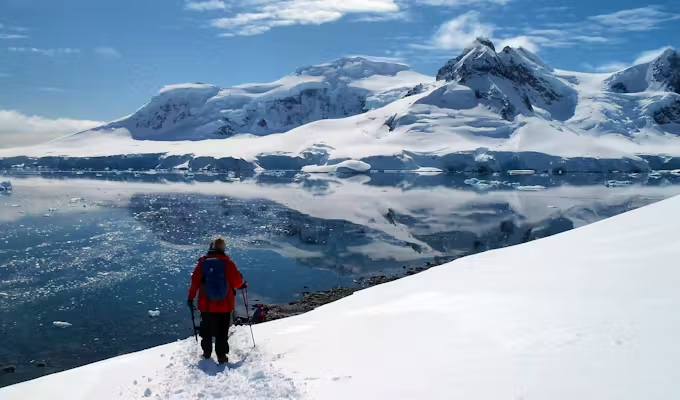
4.5 out of 5
The ultimate Antarctic adventure, this trip is specifically for the active traveller. Spend 7 days kayaking, hiking, camping, mountaineering and snowshoeing, all included in the price. A medium-sized expedition ship acts as your floating ‘basecamp’. An excellent deal backed up…

4.4 out of 5
For adventurers prioritising real comfort and ease of travel, this is a great option. Journey in style aboard a state-of-the-art expedition ship, with heli-sightseeing available on select departures for a unique bird's-eye view of Antarctica. Plus, the comprehensive transfer package…

4.3 out of 5
A rare and popular voyage which flies to Antarctica in just two hours, then sails back across the Drake Passage, maximising both expediency and experience. Spend 5 to 7 days exploring Antarctica on a small, purpose-built expedition ship, with kayaking…

4.7 out of 5
Fly over the Drake Passage in just 2 hours, both to and from Antarctica. Ideal for those wanting a high comfort level, but who have limited time or are anxious sailors. An outstanding program, successfully operated for over 15 seasons.…
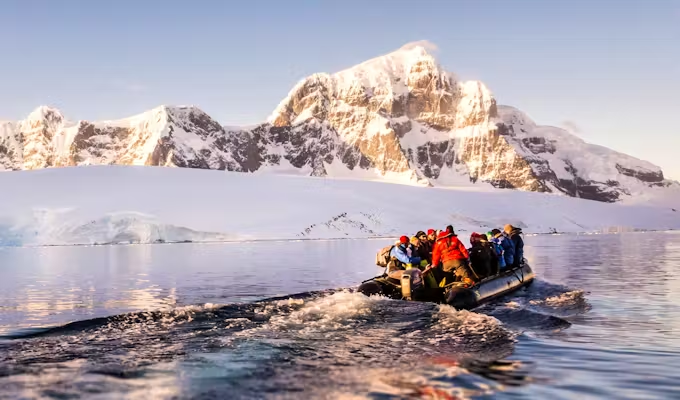
4.8 out of 5
With three medium-sized expedition ships to pick from and regular departure dates throughout the season, this well-priced voyage is a popular option. Across striking landscapes and icy seas, your company includes penguins, seals, whales and skuas. For the adventurous, optional…
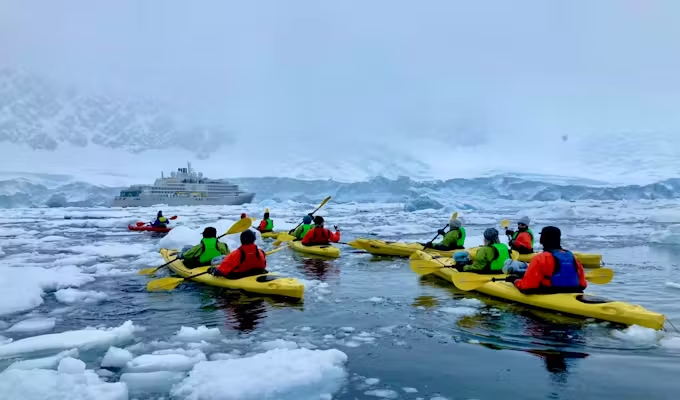
4.7 out of 5
For those travellers looking for seamless travel on a trip that is hassle-free and all-inclusive, this is the perfect option. Skip over the notorious Drake Passage on a comfortable two hour flight to Antarctica, then travel onboard a state-of-the-art mega…
Swoop has catered for travellers of every group size. Whether you’re adventuring solo or bringing a group of over 100. We can help.
Under normal weather conditions, it takes around 48 hours to sail across the Drake Passage, though crossings can occasionally take longer. Your ship's captain will be constantly monitoring the wind and wave conditions to ensure you have the fastest (and smoothest) passage possible.
The majority of Drake Passage crossings are smooth. As a general rule, fewer than one in four result in a 'Drake Shake' with big waves.
Almost all modern expedition cruise ships are equipped with underwater stabilisers to reduce the effects of the waves. Those with the most recent X-Bow design further smooth the ship's passage – although it should be noted that it is never possible to entirely counter the effects of a big sea.
The time spent crossing the Drake Passage is a brilliant way to build anticipation for Antarctica.
Wildlife watching begins the moment you start to cross the Drake, with albatrosses and other seabirds as your constant companions on the Southern Ocean. In addition, expedition guides give a series of lectures and talks during the crossing to prepare you for what you'll experience in Antarctica and get you even more excited for the 7th Continent. The two day crossing can pass surprisingly quickly: you certainly won't be bored.
On the return voyage, many people enjoy the slow crossing as a time to decompress and process their polar experience with newfound friends – as well as sorting through the thousands of photos they've taken during the trip.
Yes. The ship's doctor will have plenty of experience dealing with seasickness and may be able to prescribe you preventive drugs if necessary. In addition, they often give a briefing at the start of the voyage on the best ways to prevent and treat seasickness.
Please note that some specific drugs or other treatments like pressure patches may not be available on board. If you think you may be prone to seasickness, it's always best to consult your doctor before you travel and bring any treatments with you.
Conditions on the Drake Passage are pretty constant throughout the Antarctic cruising season, so there is no 'best' time to cross it. This means you can concentrate on choosing your trip based on the other experiences you want to have, whether that’s focused on wildlife-watching, photography or adventure activities.
For more information see our page on the best time to visit Antarctica.

The Peninsula is the classic way to experience Antarctica. Some of the best wildlife and most dramatic scenery can be found in this part of the Frozen Continent.
Discover More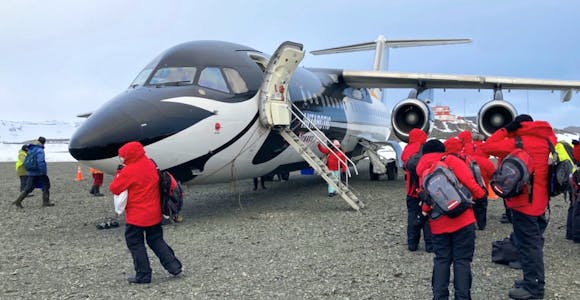
Fly & Cruise trips offer the best of Antarctica in one simple package: flying to the Peninsula in two hours to join an expedition cruise ship for a classic polar adventure.
Discover More
We work with a range of different Antarctic vessels, with expertise across the entire polar fleet, to give you the best choice of ship, cabin and departure date.
Discover More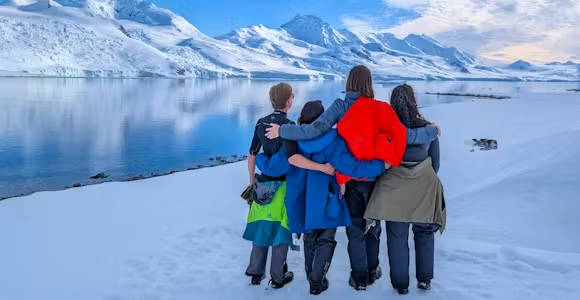
Choosing when to go to Antarctica is a key part of planning a cruise, with each month of the season offering a different side of the continent.
Discover MoreHarness our 400,000 hours of Antarctic experience. There’s no question we can’t answer.
Expert advice on over 1500 voyages to help you discover your perfect trip - and we don’t charge a fee.
We care deeply about protecting Antarctica, that’s why 1% of our revenue goes to conservation.
Access our exclusive pre-travel webinars — one of the many ways we make sure you’re Antarctica’s best-prepared travellers.
We'll spend some time listening to your aspirations, then discuss the kind of experience that might suit you.
Next we'll discuss the options, shortlist the best trips for you and present you our impartial recommendations.
We'll place a 24 hour hold on your preferred option - without obligation - whilst we talk through the details.
With over 100 years of Antarctic experience between us, we can help guide you to exactly the right trip for you.
1-888-970-4570This website uses cookies to ensure you get the best experience on our website. Privacy policy